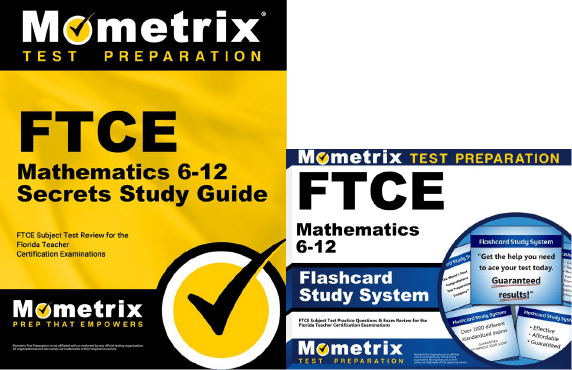If you need help studying for the FTCE Mathematics 6-12 test or just want some more information about what the test is like, you’ve come to the right place!
Click below to take a free FTCE Mathematics 6-12 practice test!
What’s on the Test?
The FTCE Mathematics 6-12 test contains 50 multiple-choice questions and is timed at 2.5 hours.
The exam is split into six competencies:
1. Number Sense, Operations, and Proportionality
8% of the exam
- Converting between rational numbers represented in various ways
- Performing operations with rational numbers
- Using estimates and algorithms
- Multi-step expressions
- Representing real number approximations with scientific notation
- Problems involving ratios and proportion
2. Algebra
19% of the exam
- Generating equivalent expressions
- Evaluating whether a relationship is a function
- Types of functions
- Solving equivalent algebraic expressions
- Slopes and intercepts of a linear function
- Absolute value and quadratic inequalities
- Systems of linear equations and inequalities
- Interpreting x-intercepts, y-intercepts, vertices, and lines of symmetry
- Solving quadratic equations over the real and complex number systems
- Graphical representations of exponential growth and decay
- Determining the inverse of a given function
3. Geometry and Trigonometry
28% of the exam
- Classify various shapes and solids
- Properties of angles
- The Triangle Sum Theorem
- Proving congruency or similarity between triangles
- Applying translations, reflections, rotations, and scaling
- Identifying the shapes of 2D cross sections of 3D figures
- Solving problems involving proportional relationships between similar 2D and 3D figures
- Perimeter, circumference, and area
- Justifying geometric constructions
- Solving problems involving the lengths and intersection angles of secants, chords, and tangent segments
- Equations and graphs representing a conic section on a coordinate plane
- Using trigonometric ratios
- The law of sines and cosines
- Converting between rectangular and polar coordinates
- Applying parametric equations to model problems involving motion in the plane
- Interpreting the language of logic
4. Data Analysis, Statistics, and Probability
19% of the exam
- Appropriate measures of central tendency
- Applying the mean and standard deviation of a numerical set of data
- Identifying displays for univariate numerical and categorical dataDetermining population total, mean, and percentages
- The properties of correlations in bivariate data displayed in scatter plots and 2-way frequency tables
- Determining the probabilities of events in experiments
- Analyzing 2-way frequency tables and relative frequency tables
- Determining an appropriate sample space for a simple experiment
- Comparing experimental and theoretical probabilities
- Calculating the expected value and standard deviation of a random variable
5. Precalculus and Calculus
16% of the exam
- Solving problems involving quantities that can be represented by vectors
- Solving problems using exponential and logarithmic functions and equations
- The Fundamental Theorem of Algebra
- The Factor Theorem
- Applying arithmetic and geometric sequences
- Determining limits using theorems pertaining to sums, products, and quotients of functions
- Applying definite integrals to solve problems involving distance, volume, and area
- Calculating binomial expansions to a positive integral power
6. Student Reasoning and Instructional Practice
10% of the exam
- Facilitating instruction in using mathematical concepts and procedures with fluency
- Identifying opportunities for students to evaluate reasonableness of their results
- Identifying patterns to make connections between mathematical and real-world problems
- Selecting appropriate mathematical representations and instructional tools
- Analyzing learning progressions
- Interpreting individual student mathematics assessment data
- Analyzing mathematical misconceptions, errors, and knowledge gaps
How to Register
To get started with the registration process, you’ll need to create an FTCE/FELE account on their website. You can then register for the exam via your account.
How the Exam is Scored
The FTCE Mathematics 6-12 test is scored using a scaled scoring method. Here’s how it works:
For every question you answer correctly, you get one point added to your raw score. At the end of the test, your final raw score will be converted to a scaled score.
The reason your raw score is converted to a scaled score is because everyone that takes the test is given a slightly different set of questions. Since everyone has a different arrangement of questions, and because some questions are harder than others, converting your raw score to a scaled score ensures a more even playing field.
FAQs
How many questions are on the FTCE Mathematics 6-12 exam?
The exam contains 50 questions.
What is the time limit for the FTCE Mathematics 6-12 exam?
The exam is timed at 2.5 hours.
What is the passing score for the FTCE Mathematics 6-12 exam?
You’ll need to get a final scaled score of at least 200 to pass.
How much does the FTCE Mathematics 6-12 exam cost?
The testing fee is $150.
Mometrix Test Preparation is not affiliated with or endorsed by any official testing organization. All organizational and test names are trademarks of their respective owners.



 FTCE Study Guide
FTCE Study Guide FTCE Flashcards
FTCE Flashcards